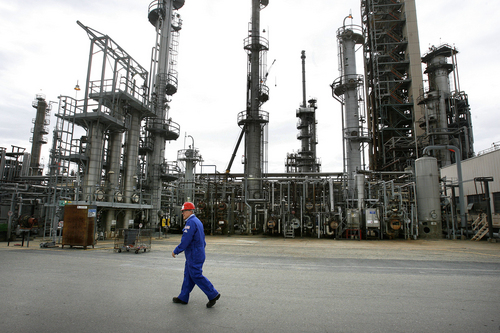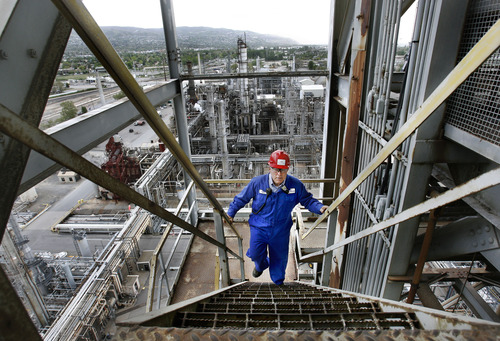This is an archived article that was published on sltrib.com in 2014, and information in the article may be outdated. It is provided only for personal research purposes and may not be reprinted.
Everyone from Gov. Gary Herbert to environmentalists believes low-sulfur gasoline could play a critical role in relieving the Wasatch Front's air quality mess.
But Utah has little power to force local refiners to make so-called Tier III fuels available sooner than the federally mandated 2020 deadline, state environmental officials told lawmakers on Wednesday.
Instead, state leaders hope to provide "carrots," or incentives, to encourage Salt Lake's five refineries to speed up the transition to gasolines with sulfur contents less than 10 parts per million (ppm).
Just by using cleaner fuels, vehicle emissions would be reduced by 7 to 11 percent, Division of Air Quality director Bryce Bird told the State Natural Resources, Agriculture and Environment Interim Committee.
"It is a large benefit to air quality at a very reasonable cost," Bird said.
But Republican committee members worried the state could go too far in its efforts to clear the air.
Committee members Wednesday questioned whether providing incentives to speed up Tier III fuel delivery to Utah would meddle in refiners' business or breach the separation of powers between the governor and lawmakers.
Sen. Scott Jenkins, R-Plain City, suggested regulations get in the way of refiners' progress.
And West Jordan Republican Rep. Ken Ivory said regulators could overstep executive authority by imposing requirements that should be the purview of the legislature.
"This happens to be a rule that is addressing a situation in a cost-effective way," said Alan Matheson, the governor's environmental adviser. "We believe bringing in those cleaner fuels and vehicles helps us with our economy, helps public health and helps our quality of life."
Sen. Jim Dabakis, D-Salt Lake City, wants faster action, arguing there are "sticks" that should be applied as well.
"The state's position is: Trust the big oil companies," Dabakis said. "They say good things to us, but when it comes to actual commitments, we could well end up [getting Tier III fuel] in 2028, rather than 2018, if at all. It has me really worried."
The U.S. Environment Protection Agency is requiring carmakers to begin making cleaner Tier III automobiles available by model year 2017 and refiners to cut sulfur content from the current 30 ppm standard to 10 ppm by 2020.
The rules give targets, but allow the companies to determine the best way to achieve them, Bird said.
Under that flexibility, the sulfur standard sets a target for a corporate average, rather than imposing limits on each U.S. refinery. That means a Salt Lake operation could remain above the standard as long as its corporate parent hits the target across its operations.
Matheson said three of Salt Lake's refineries, representing 90 percent of the local industry's output, are exploring how to meet the 2020 deadline.
HollyFrontier is conducting an engineering analysis to see how it can produce Tier III fuels as early as 2018. Collectively, the refiner already has invested $1 billion in emission-cutting upgrades. Meeting Tier III standards would required millions of dollars more in upgrades.
Holly's Woods Cross refinery, one of five it operates around the nation, has already achieved a sulfur reduction to 15 ppm.
"The fuel we produce now is close to the standard. To put in the equipment to get the last bit out is cost-ineffective," Holly environmental manger Mike Astin said. "You would notice no difference in the quality of the air, and yet it would be a multimillion-dollar investment."
Astin cautioned there is "no sulfur knob," and removing sulfur can increase emissions from the refinery itself. The equipment that removes sulfur forces hydrogen under pressure into the gasoline. It bonds with the sulfur, becoming hydrogen sulfide gas, which itself must be captured to limit pollution.
"We could meet that on a corporate basis by averaging our production with our four other refineries," Astin said. "We are looking at what we need to do to meet it at a local basis."
Holly is the smallest of Salt Lake's refineries, but it is currently getting permits to double its daily refining capacity to 60,0000 barrels.





